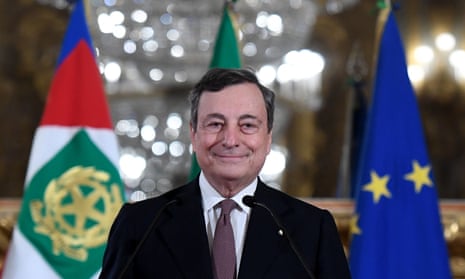Italy’s new government, led by former European Central Bank chief Mario Draghi, will be sworn in on Saturday, ending weeks of political turmoil.
Draghi, 73, announced his cabinet, which contains a mix of political and technocratic ministers, to president Sergio Mattarella on Friday.
Some roles were reconfirmed, such as Luigi Di Maio as foreign minister, Roberto Speranza as health minister, Luciana Lamorgese as interior minister and Dario Franceschini as culture minister.
The economy ministry has gone to Daniele Franco, the current director-general of the Bank of Italy, and the justice ministry to Marta Cartabia, who until last September was president of the Constitutional Court.
The government – Italy’s third administration in less than three years – will face votes of confidence in both houses of parliament on Monday and Tuesday.
Draghi, a respected figure at home and internationally, managed to convince almost all of the country’s main parties to support his government, with leaders from the far-right League and populist Five Star Movement (M5S) adopting more moderate, pro-European tones in recent days.
Draghi also agreed to install a new “ministry of ecological transition”, headed by Roberto Cingolani, chief technology and innovation officer at Leonardo SpA, as one of the conditions to secure M5S’s support.
Draghi also has the backing of Italians, with more than 60% supporting a Draghi-led government in a survey on Thursday. In a poll earlier in the week, more than 50% said they hoped Draghi’s leadership would last until the natural end of the administration in 2023.
Draghi’s appointment ends weeks of political turmoil triggered after Matteo Renzi withdrew his Italia Viva from a ruling coalition made up of M5S and the centre-left Democratic party due to clashes over how the government was planning to spend the €200bn-plus which Italy is poised to receive from the EU’s Covid-19 recovery fund. Renzi’s move led to Giuseppe Conte stepping down as prime minister.
Draghi, nicknamed “Super Mario” for his role in saving the euro, also has overwhelming support from the Italian press, which over the last week has feted him as “a new Italian miracle”.
The expectations that he will be able to reverse Italy’s fortunes are therefore as high as the stakes. Among his first major tasks will be to accelerate a vaccination programme as Italy strives to emerge from the coronavirus pandemic, which has so far claimed 93,000 lives, while at the same time rescuing the economy from the worst recession since the second world war.
The last time a technocrat was appointed in Italy was in 2011, when Mario Monti was entrusted with leading the country out of an acute debt crisis that prompted Silvio Berlusconi’s resignation as prime minister.
Monti also started with a strong approval rating among the public, only for his popularity to diminish as austerity measures kicked in. A major difference between the two tenures is that Draghi will have money to spend rather than having to enact cuts.
He is expected to devise a strong and feasible plan for the EU recovery money. A big challenge, however, will be implementing the plan while pushing through EU-requested reforms that will probably trigger fierce battles among the various parliamentary factions.
“I’m not so sure it will be so easy for Draghi to do what everyone’s expecting him to do,” said Mattia Diletti, a politics professor at Rome’s Sapienza University.
“The press is depicting him as Jesus Christ who is able to heal the child with the touch of a hand – they’re waiting for him to fix the issues. My question is what happens to the country if Mario Draghi doesn’t fix the issues?”
Diletti also fears the impact another technocratic government will have on Italy’s democracy. M5S emerged as a powerful force in the 2013 general election partly as a reaction to Monti’s government. M5S is still the largest party in parliament but has lost more than half of its supporters since general election in March 2018.
The main party to oppose Draghi was Giorgia Meloni’s far-right Brothers of Italy, which is also the only force to have grown in popularity over the past year.
“At what cost will it be for democracy, if for a second time in 10 years the political system is unable to work?” said Diletti.
